Intel Launches Xeon W-3300: Ice Lake for Workstations, up to 38 Cores
by Dr. Ian Cutress on July 29, 2021 11:00 AM EST- Posted in
- CPUs
- Intel
- Xeon
- Workstation
- 10nm
- Ice Lake
- Xeon Scalable
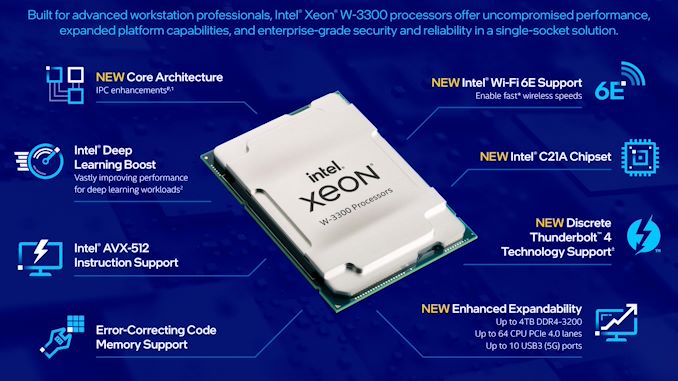
With the launch earlier this year of Intel’s Ice Lake Xeon Scalable platform, the first Intel enterprise platform based on 10nm, we were always wondering to what extent this silicon would penetrate other markets. Today Intel is answering that question by launching the Xeon W-3300 family, using the same Ice Lake Xeon silicon but in a more focused single socket platform. Xeon W-3300 will offer processors from 12 core up to 38 cores, peaking at 270 W TDP, but offering support for up to 4 TB of memory.
The Xeon W-3300 Family
This is the third generation of Intel’s Xeon W processor family, initially highlighted by the overclockable 28-core Xeon W-3175X based on the Skylake family of enterprise CPU architectures. Intel made a big effort with the launch of that processor, and followed it shortly with the Xeon W-3200 series based on Cascade Lake, offering more PCIe lanes and an increase in frequencies. The new Ice Lake Xeon W family uses Intel’s Ice Lake architecture, as we highlighted in our initial Xeon Scalable review of the platform, affording a sizeable gen-on-gen bump performance improvement against the previous Intel processors. In that review we’ve highlighted that Ice Lake offered a good +19% IPC increase, and the gain in core count and TDP provided an uplift despite some regressions in frequency compared to Cascade Lake.
While the Xeon Scalable line offers up to 40 core variants, Xeon W-3300 will go as far as 38 cores, but Intel is focusing mostly on the 32-core version as its lead product. The new Xeon W-3365 with 32 cores is designed to be competitive against AMD’s Threadripper Pro 3975WX, which we recently reviewed, offering the same number of cores, the same DRAM support, and has some tradeoffs.
| Intel Xeon W-3300 Ice Lake SKUs | |||||||
| AnandTech | Cores | Base Freq |
1T Turbo |
nT Turbo |
L3 (MB) |
TDP | Price (1ku) |
| W-3375 | 38 / 76 | 2500 | 4000 | 3300 | 57 | 270 W | $4499 |
| W-3365 | 32 / 64 | 2700 | 4000 | 3500 | 48 | 270 W | $3499 |
| W-3345 | 24 / 48 | 3000 | 4000 | 3700 | 36 | 250 W | $2499 |
| W-3335 | 16 / 32 | 3400 | 4000 | 3700 | 24 | 250 W | $1299 |
| W-3323 | 12 / 24 | 3500 | 3900 | 3700 | 21 | 220 W | $949 |
The top processor is the Xeon W-3375 with 38 cores and 76 threads. The base frequency of 2.5 GHz is offset with a 4.0 GHz single core turbo and a 3.3 GHz all-core turbo, enabled through the 270 W TDP, which increases the TDP of the top Xeon W processor from 255 W in the previous generation.
All the processors will support 64 lanes of PCIe 4.0, 8-channel DDR4-3200 memory (up from 6-channel), and with 256 GB LRDIMMs up to 4 TB per socket (16 modules). The standard Ice Lake enterprise core offers 1.5 MB of L3 cache per core, and for all the processors here that standard stays the same, however the 12-core version uses 1.75 MB of L3 cache per core. Intel has not disclosed the die configurations of the lower core count parts, however the 28+ core parts are almost certainly using the 40 physical core configurations.
These new processors use the same LGA4189 socket as the mainline Xeon Scalable platform, but are enabled through a new generation of C621A chipset which allows for Wi-Fi 6E and Thunderbolt 4 expansion on motherboards should the board OEM built it in. Further information about the C621A has not been detailed at this time.
The other angle new to the Xeon W family is the addition of new instructions for cryptography – Ice Lake cores now support SHA extensions, have doubled AES throughput, and VPMADD52 instruction sets. On top of this, Intel is pushing its latest generation of DLBoost technology to speed up AI workloads through efficient use of the on-board AVX512 units. Although not disclosed, we are under the impression that the Xeon W-3300 parts have dual AVX512 FMAs per core.
Some Xeon W-3365 Benchmarks
Ahead of this launch, we were contacted by a system integrator who shipped us a system that arrived a couple of days ago with the W-3365 installed. Unfortunately the system didn’t survive the transatlantic shipment entirely intact, and we’re still debugging exactly why. But we were able to strip out the board and CPU to do some initial testing. We’re going to be doing a full review hopefully next week.
- Processor: Intel Xeon W-3365 (32-core Ice Lake, 270W)
- Cooler: Noctua NH-U14S LGA4189
- Motherboard: Supermicro X12SPA-TF
- Memory: 8 x 16 GB of DDR4-3200 RDIMM (128 GB)
- Graphics: NVIDIA RTX 3090 FE
- Storage: Intel Optane P5800X 800GB + 2x1 TB Samsung 980 Pro
- Power Supply: 2x Corsair AX860i
- Operating System: Windows 10 20H2
We’re comparing this processor to the 28-core W-3175X and the 32-core TR Pro 3975WX in these initial tests. Intel is targeting this processor very much at workstation-dedicated workflow. Also, the benefit of all these processors listed being 32-core or below means they fit inside Windows’ 64-thread mask limit, which can limit some tests to 64 threads.
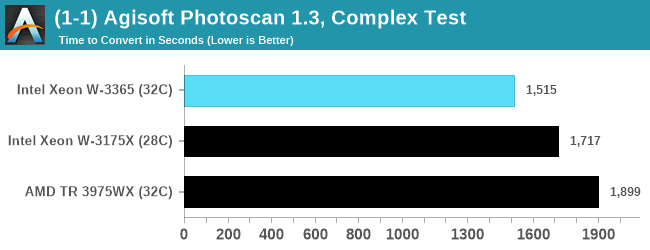
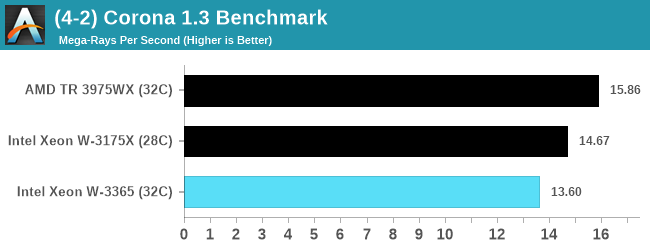

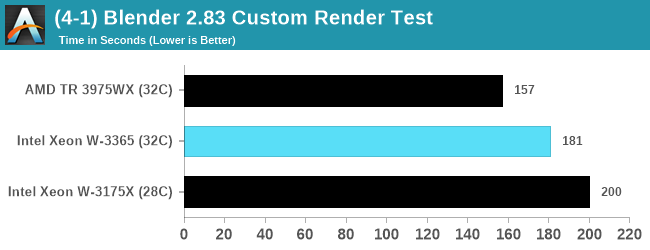
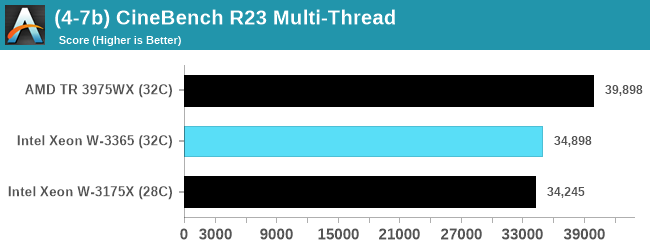
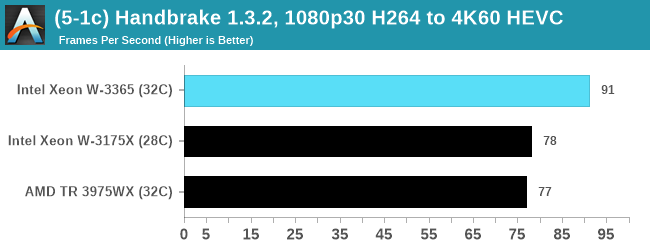

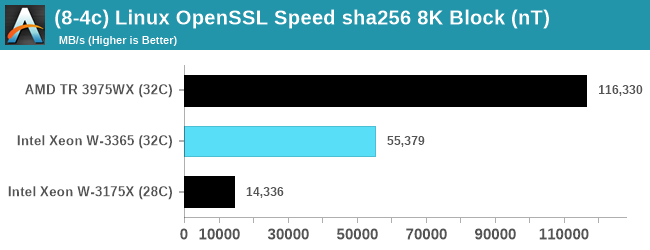
When it comes to power, we're measuring a peak 292 W during AVX-512 workloads and 286 W in AVX2 workloads, however this is preliminary data from a few tests we've been able to run so far.
We can see that the Ice Lake Xeon W-3365 already pushes ahead of the Skylake W-3175X in almost all our benchmark suite, save for a couple of tests that seem to be cache/frequency-dependent. Against the Zen 2-based 3975WX it is more benchmark dependent. We are waiting for AMD to launch its Zen 3-based Threadripper and TR Pro over the next few months.
| Xeon W-3175X vs Xeon W-3365 vs TR Pro 3975WX | |||
| Intel Xeon W-3175X |
Intel Xeon W-3365 |
AnandTech | AMD TR Pro 3975X |
| $2999 | $3499 | Cost | $2750 |
| Skylake Xeon | Ice Lake Xeon | Microarchitecture | Zen 2 |
| 28 / 56 | 32 / 64 | Cores / Threads | 32 / 64 |
| 3100 MHz | 2700 MHz | Base Frequency | 3500 MHz |
| 4300 MHz | 4000 MHz | Turbo Frequency | 4200 MHz |
| 1024 KB | 1280 KB | L2 Cache / core | 512 KB |
| 38.5 MB | 48 MB | L3 Cache | 128 MB |
| 255 W | 270 W | TDP | 280 W |
| 6 x DDR4-2933 | 8 x DDR4-3200 | Memory | 8 x DDR4-3200 |
| 512 GB | 4 TB | Memory Capacity | 4 TB |
| PCIe 3.0 x48 | PCIe 4.0 x64 | PCIe | PCIe 4.0 x128 |
| PCIe 3.0 x4 | PCIe 3.0 x8 | Chipset Link | PCIe 4.0 x8 |
| Yes | Yes | AVX-512 | No |
We’re hoping to put more time into testing this platform, along with the rest of the system sent to us; workstations rarely focus solely on the CPU, and rely very much on the installed graphics, storage, and memory depending on the different bottlenecks of the workload. Stay tuned for that review.










45 Comments
View All Comments
sara-windowdeco - Thursday, July 29, 2021 - link
This is already a hard sell compared to the old TR let alone the upcoming TR.SarahKerrigan - Thursday, July 29, 2021 - link
Looking at the specs and benches, it seems pretty reasonable against the 3975WX. I suspect that's going to be a tougher compare when Milan-based TR Pro launches, though...brucethemoose - Thursday, July 29, 2021 - link
That all depends on pricing and availability.Milan TR might be unobtanium. Heck, many Rome TR SKUs (like the 3990X that will inevitably draw some comparisons) are *still* impossible to get at MSRP.
JayNor - Thursday, July 29, 2021 - link
The workstation chips don't have UPI lanes, so AMD would not support multi-socket coherency.It will be interesting to see if Intel enables multi-socket workstations that use cxl for coherency when Sapphire Rapids workstation chips are launched. I could see this working with their new IPU idea.
JayNor - Thursday, July 29, 2021 - link
correct ... meant the Intel workstation chips would not support multi-socket coherency...mode_13h - Monday, August 2, 2021 - link
> Looking at the specs and benches, it seems pretty reasonable against the 3975WX.Let's compare frequencies & pricing, and also with non-Pro 32-core TR:
Model - Freq (GHz) - MSRP
---------------------------------------
Xeon W-3365 - 3.5/4.0 - $3500
TR 3975WX - 3.5/4.2 - $2750
TR 3970X - 3.7/4.5 - $2000
Price/perf is not really competitive with TR Pro, and not remotely with normal 32-core TR.
The only compelling reason to buy WX-3300 is for the system-level upgrades (PCIe 4.0 lanes; memory) for those compelled to stay with Intel (or who cannot source TR).
The 16-core seems most compelling, if you needed more I/O than a Ryzen AM4 system could provide and yet 16 cores was enough compute. Multi-GPU deep learning workstations come to mind.
YB1064 - Wednesday, August 4, 2021 - link
TR Pro has a lot more PCIe lanes, making it very attractive for a workstation build. Hell everything about the TRPro is better. Why would anyone spend MORE money for an inferior product? If you say AVX512, I'm gonna slap you silly...mode_13h - Thursday, August 5, 2021 - link
> Why would anyone spend MORE money for an inferior product?Some people are stuck in the Intel ecosystem, for whatever reason. Whether it's what their software vendor is certifying or maybe it's what their corporate IT department will purchase. A lot of big OEMs, like Dell, are still mostly in the Intel camp.
Availability is another reason.
> If you say AVX512, I'm gonna slap you silly...
I've criticized it many times, but it really comes down to the software you need to run. If it's CPU-bottlenecked and they've optimized it for AVX-512 (which could be as simple as using Intel-provided optimized libraries), then it's a legitimate consideration. More cores can *usually* offset the difference, but not always.
As you point out, Intel is facing a real challenge in Threadripper. I see this as mostly a stop-gap measure, to keep them marginally in the game until they can release something based on Sapphire Rapids.
shanti_shakti - Thursday, July 29, 2021 - link
Compared to the W-3345 at $2499, the EPYC 7443P-based workstations I’ve just built have twice the PCIe lanes, higher all-core boost clocks, over 3x the L3 cache, use a third less power and cost $1337 per CPU.With these high-frequency EPYC Milan chips about, TR Pro is a dead platform until the Zen 3 based chips launch, if ever.
Mikewind Dale - Thursday, July 29, 2021 - link
Where did you find an EPYC 7443P to buy? It's easy to find ThreadRipper Pros for sale, but everywhere I saw an EPYC 7443P listed it as backordered.